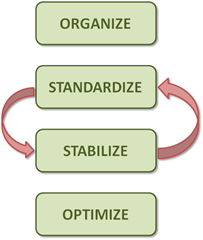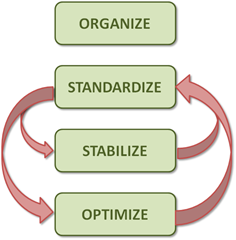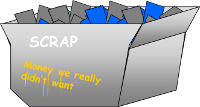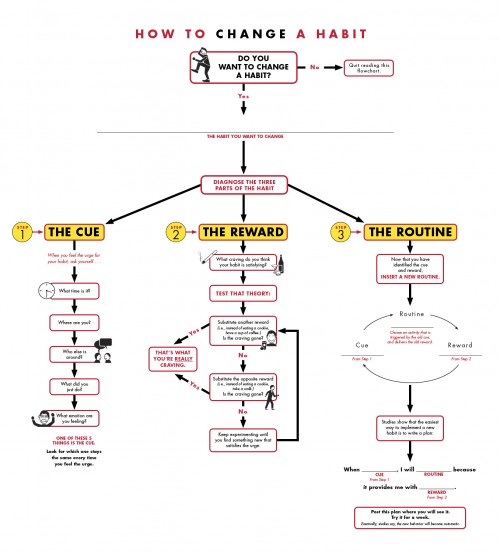As I work in the field, I continue to encounter a desire to get right to optimal results – “Why aren’t we working to eliminate all of the waste?”
Once people start seeing opportunities, there is a great temptation to try to simply engineer a new process and implement it. This is especially true in value stream mapping processes. The future state map seems like an engineering specification – just make it look like this, and all of these issues will go away.
The “kaizen bursts” are supposed to represent the obstacles in the way, but they often show up as “action items” instead as people are tempted to make this into a project.
But the messy reality in the actual workplace (gemba) requires a far more methodical approach.
The title of this post is from four steps that a consultant friend shared with me years ago. As I converge my own practice toward guiding people through implementing the daily improvement culture vs. implementing the tools, I am finding these words a handy mantra. This is how I have found myself explaining it lately:

Organize includes all steps required to make the current condition apparent. This can include 5S activity, but is by no means limited to that.
You want to know enough about what is going on that you can tell the normal, intended, pattern from one which has been disrupted by an obstacle or issue.
In other words, you know how the process should operate if people don’t encounter any serious issues.
This allows you to standardize.
This is not a standard in terms of something you are trying to enforce.
Rather, it is a standard that you are striving to achieve each and every time the process is run.
“Did we make takt time with this work cycle?”
“Did this changeover go the way we intended?”
“Did we make a good part this time?”
(for Brian): “Did we get the quote out in two days?”
Once you know how the process is supposed to work, and what results you are supposed to get, you can clearly identify those times when it doesn’t work that way, or the results are not what you wanted.
 Stabilize: Now you can begin marching up the PDCA ramp toward the standard as you work to stabilize the process by systematically eliminating the issues.
Stabilize: Now you can begin marching up the PDCA ramp toward the standard as you work to stabilize the process by systematically eliminating the issues.
Of course, for this to actually work, you must have a process to flag problems right away, pounce on them, clear them, and then feed them into a follow-on process that works to solve them.
As you apply countermeasures to sources of instability, you are adjusting the standard itself to include those countermeasures, making it more robust.
So Stabilize and Standardize play off one another in successive PDCA cycles.
 Now… here is the trick part. “Optimize” can be indistinguishable from “Stabilize.” It is more of a semantics issue than anything else, and honestly, it isn’t worth arguing about.
Now… here is the trick part. “Optimize” can be indistinguishable from “Stabilize.” It is more of a semantics issue than anything else, and honestly, it isn’t worth arguing about.
Why?
Because as a process becomes stable, you are going to keep driving toward perfection, True North. You are going to have intermediate-term goals you are trying to reach that keep you moving forward. You are optimizing as long as you are moving in the right direction. So there isn’t really a distinctive point of shifting gears, there is only the most important issue to address right now to hit the next target condition.




